South Korea Winter Birding Tour Report January 2024
Tour Leaders: Nick Upton, Nial Moores & Lee Collins
Dates: 3rd – 15th January 2024
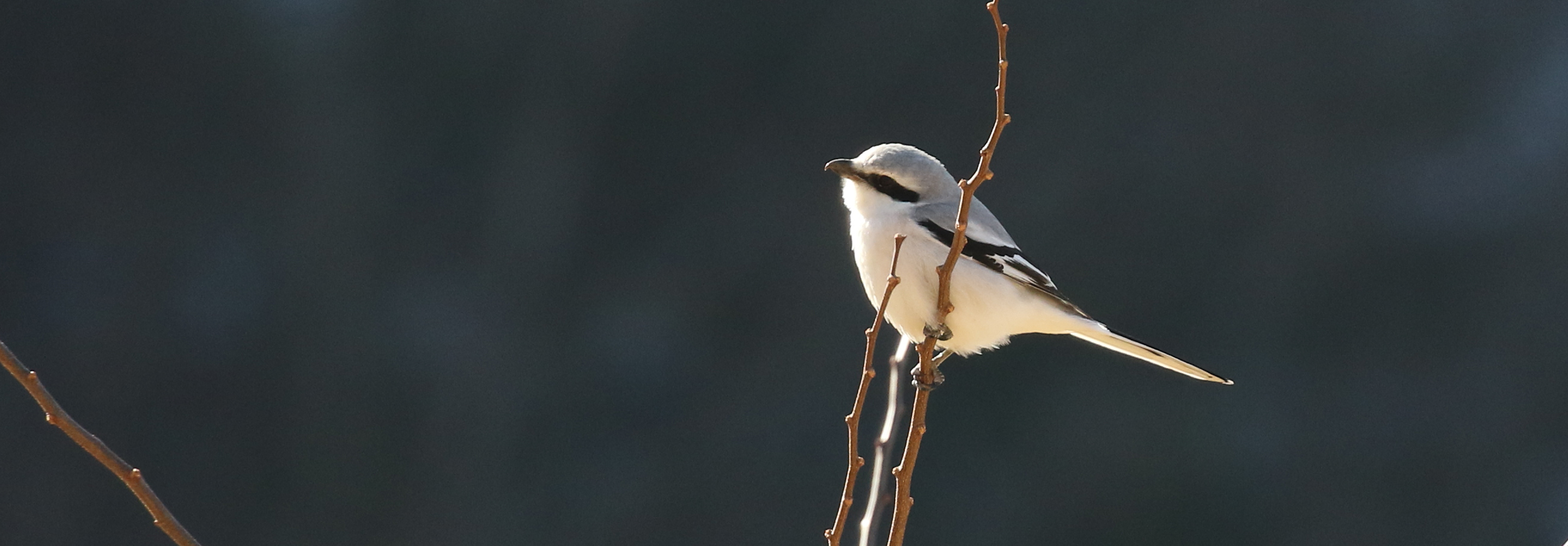
South Korea Winter Birding Tour Highlights: This list is of bird species that were the most memorable of the tour for a variety of reasons including rarity, the spectacle created by sheer numbers, the quality of the view, an interesting behavioural observation, because one of the group members had a personal connection with them or simply because of the expectation of seeing them.
- Swan Goose
- Mandarin Duck
- Baikal Teal
- Harlequin Duck
- Stejneger’s Scoter
- Smew
- Scaly-sided Merganser
- White-naped Crane
- Red-crowned Crane
- Hooded Crane
- Long-billed Plover
- Solitary Snipe
- Saunders’s Gull
- Relict Gull
- Glaucous-winged Gull
- Oriental Stork
- Cinereous Vulture
- Hen Harrier
- White-tailed Eagle
- Steller’s Sea Eagle
- Upland Buzzard
- Long-eared Owl
- Japanese Pygmy Woodpecker
- White-backed Woodpecker
- Bull-headed Shrike
- Chinese Grey Shrike
- Azure-winged Magpie
- Yellow-bellied Tit
- Varied Tit
- Chinese Penduline Tit
- Vinous-breasted Parrotbill
- Pale Thrush
- Naumann’s Thrush
- Dusky Thrush
- Siberian Accentor
- Brown Dipper
- Japanese Wagtail
- Chinese Grosbeak
- Japanese Grosbeak
- Pallas’s Rosefinch
- Long-tailed Rosefinch
- Common Crossbill
- Eurasian Bullfinch
- Meadow Bunting
- Chestnut-eared Bunting
- Yellow-throated Bunting
- Pallas’s Reed Bunting
Summary
The list of highlight species above illustrates very clearly the high quality of the birds seen on this 2024 South Korea Winter Birding Tour but what it does not capture is the abundance of birds more or less everywhere we went but also the scale of numbers that many of them were seen in. As usual with this tour we found a very high proportion of our target species and witnessed some incredible wonders of the natural world with the Baikal Teal and crane flocks. Beginning at Incheon some pre-trip birding gave us a nice introduction to some of South Korea’s wintering birds before starting the tour proper with a bang in the form of superb views of Steller’s Sea Eagle. Following on from this we visited the lovely National Arboretum where Pallas’s Rosefinch lit up the forest and Solitary Snipe delighted us in the fast-flowing stream. Our next stop was the border region where stunning Red-crowned Cranes and White-naped Cranes were the highlight and Japanese Wagtail closed proceedings in a shallow river before a woodland walk turned up a surprise in the form of Japanese Grosbeak. Heading to the east coast we picked up a wide variety of seabirds and gulls before reaching Busan in the south where we were reintroduced to Steller’s Sea Eagle. At Junam we had a really big day list of species and another wonderful experience with White-naped Cranes while further west we were treated to superb views of Scaly-sided Mergansers then Hooded Cranes and raptors at Suncheon Bay. Birding from Gunsan was extremely good with some magical moments including 800,000 Baikal Teal and a Relict Gull at point blank range. Moving up the west coast we stopped in at Seosan for Oriental Stork before finishing with a wonderful White-backed Woodpecker at Namhanseong then back to Incheon to conclude our South Korea Winter Birding Tour.
Join us on our next winter birding tour to South Korea. See the full itinerary and book here – South Korea Winter Birding Tour.
Field Guide
Birds of East Asia by Mark Brazil, published by Helm. In the absence of a quality field guide devoted to South Korea this publication is more than adequate and contains all the species seen on this birding tour. The checklist issued to clients was based on IOC taxonomy with reference to names used within this field guide.
Day 1; 3rd January – Arrival, Incheon
Although this day was scheduled as arrival day only, all members of the group had arrived by early afternoon which gave everyone time to do some birding in the nearby park and large areas of rough land and surrounding coast. The hotel that we use here is well-situated for an afternoon or morning of birding after arrival with a good selection of South Korea’s commoner winter birds present and even the possibility of one or two more scarce species depending on the weather conditions.
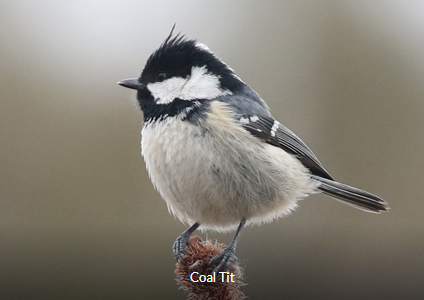
Perhaps no rarities this year but a surprise was the numbers of Light-vented Bulbuls in the area. Feeding in the under storey were at least 26 of these crisp-looking birds. A fairly recent colonist to South Korea they were more usually seen in the milder southern areas of the country so to see this many was notable but part of their spread throughout the peninsula that Nial confirmed when we met him.
Plenty of Coal Tits were easily seen too, a bird that in previous years we had only seen in conifereous woodland but groups of chattering Vinous-throated Parrotbills in reeds and undergrowth were far more familiar here. Flocks of oriental (Grey-capped) Greenfinches were also notable, a bumper crop of seeds in the area attracting them to feed with a few smart Yellow-throated Buntings joining them. A small number of Naumann’s Thrush provided a much hoped-for bird for some members of our group and a Daurian Redstart was the first of many of this attractive bird that we would see on the tour.
Taking a look out on the surrounding water and mudflats supplied our first views of some species that would become very familiar over the course of the tour, including Black-tailed Gulls in a variety of plumages. A couple of Red-breasted Mergansers were feeding just offshore and a flock of Eastern Spotbilled Ducks were the first of very many. Some passing gulls appeared to be Mongolian Gulls but we decided to leave those until later when we would get point blank views and, for many people, Common Pheasant was the first genuinely wild bird that many of the group had seen. This pre trip birding was a nice introduction to the birds and we finished the day with our introductions to each other over a warming dinner close to the hotel.
Day 2; 4th January – Paldang – National Arboretum
How to kick off the tour with a bang? Well, how about going straight for one of the most anticipated birds of the trip? Steller’s Sea Eagle. We were able to leave our hotel in Incheon early so that we were able to arrive at the Han River at Paldang an hour or so after first light. Our first viewing point was pretty cold but things had not been cold enough to freeze the river, meaning that there were no icy patches for eagles to sit on. A scan of the river revealed good numbers of common Eurasian wildfowl such as Whooper Swan, a big flotilla of Common Pochard with smaller numbers of Tufted Duck among them, handsome Common Goldeneye and a whole load of Great Cormorants but things did not look promising for much more so we swiftly reboarded and drove a short distance to viewing spot number two which immediately looked much more interesting.
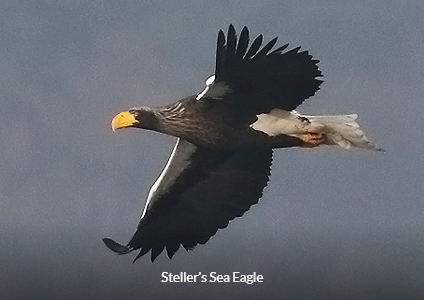
A crowd of photographers stood prepared for some sort of avifaunal show, overlooking a stretch of river that contained many mid-channel rocks, with wooded hillsides either side. We were able to find a couple of parking spaces for our vehicles and located a safe place to stand as the locals told us that the expected eagles had not yet arrived. “They will arrive soon then”; no sooner had I said it a magnificent adult Steller’s Sea Eagle came swooping in and flew right past us all, circling around for more than five minutes over the river at eye level. This was an experience more phenomenal than any of us had imagined possible.
Joining the party was a juvenile White-tailed Eagle, looking small in comparison to the massive Steller’s, which by now had landed on a tree on the opposite bank of the river. Watching and waiting for a second flight from the Steller’s Sea Eagle gave us a chance to look at some of the other birds in the area including a colourful male Daurian Redstart darting around in the undergrowth behind us while a flypast Common Redpoll was heard by many but only seen by Nial and myself which was a shame considering its scarcity in South Korea. In the trees nearby we were able to get a nice view of a colourful Naumann’s Thrush and enjoy some smart Oriental Greenfinches and a nice Brambling perched in the open trying to take advantage of some rays of sunshine squeezing through the cloud cover.
Turning our attention to the water we were able to enjoy a few stunning male Smew but we would get even better views later in the trip, while Duncan picked out a Greater Scaup among the other diving ducks. Our first Mongolian Gull of the trip repeatedly cruised up and down the river but we were not able to find a Scaly-sided Merganser here this year, however, with other sites to search for them we were not too worried. Instead we had to satisfy ourselves with the first Goosanders of the tour, a species that we would see frequently along the way. As it seemed like the Steller’s Sea Eagle was happy on its perch and it seemed unlikely that we would get better views we decided, in terms of time management, to be on our way to the National Arboretum where we could get some lunch before resuming the birding.
As it turned out we were able to continue birding while eating our lunch in a small restaurant near the arboretum with an Eastern Buzzard seen through the large picture window followed by a flypast Black Woodpecker!
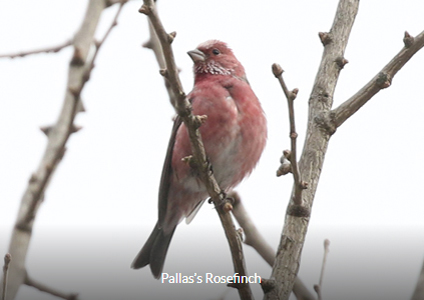
In the arboretum itself a coating of snow had turned the location into a sort of winter wonderland, creating a beautiful setting for our afternoon’s birding. This is always one of my favourite locations, with good views of nice birds virtually guaranteed and a lovely place for the first day of the trip. Common species such as Marsh Tit, Eastern Great Tit and Brown-eared Bulbul were seen from the car park and it did not take much longer for our first Varied Tits to show up. This is a fairly common and widespread bird in South Korea but nevertheless, it is always a pleasure to see, a bird that brings a smile to everyone’s faces such is its colour and character. A flock of small birds produced some excitement with Eurasian Nuthatch, Coal Tit, Yellow-throated Bunting and a much-wanted Japanese Pygmy Woodpecker. This tiny little woodpecker is a fairly common bird here but it was still great to watch them at close range going about their business. After the flock passed through the soft call of Eurasian Bullfinch caught our attention and we tracked down a few of these smart birds after some effort and, in fact, following them for better views led us onto a real cracker of a bird: Pallas’s Rosefinch. As we slowly got closer for a better view of the three Pallas’s Rosefinches that were perched in a bare tree, several more joined them to form a flock of eight birds. Remarkably they allowed us to approach to quite close range giving the photographers among us exactly what we wanted.
Shifting our attention to the stream that runs through the arboretum we somewhat nervously started our search for the main target bird here: Solitary Snipe. Nervous because each year the disturbance levels along the stream get greater and there had been no sightings of this cryptic bird this winter. However, enough secretive habitat still exists and I had confidence in Nial finding the birds if they were there at all and indeed, as some of us were scanning one section of the stream, Nial located a Solitary Snipe bobbing around in rough, waterside vegetation. We were all able to watch this attractive wader going about its business in the rushing stream until it eventually sneaked off into an area in which we could no longer see it. It is always nice to connect with target birds and this one always gets Nial and I concerned but this one kept up our 100% record over the course of six tours together. With this success behind us we took a more extended walk around the site, coming across a feeding area frequented by Pallas’s Rosefinches, Marsh Tits and Eastern Great Tits. In some coniferous trees we found a Goldcrest and a couple of Eurasian Treecreepers performed really well for us before we headed off to our accommodation in Jeongok and a steaming dinner to warm us up. And maybe a bottle or two of Soju were consumed.
Day 3; 5th January – White Horse Hill & Cheorwon
Cranes in big numbers are one of the main draws to birders visiting South Korea in winter and this day, this morning in particular, is usually one of the most memorable of the tour. Arriving at White Horse Hill, shortly after first light we walked up to the observation area before the show began. This location is one where we always need our warmest clothes but this year temperatures were rather milder than on previous visits; cold for sure, but not extreme. Having reached the viewing spot the birds began to come quite quickly with a White-tailed Eagle and some Greater White-fronted Geese in flight but it was the cranes that set things alight as they began to emerge from the DMZ and flew towards us in ones and twos and then in increasing numbers. Delightful Red-crowned Cranes cruised along and landed in fields close to us, allowing us to appreciate them in flight and on the ground. The haunting calls of both these and the equally elegant White-naped Cranes as they built up into big numbers created an atmosphere that would long be remembered.
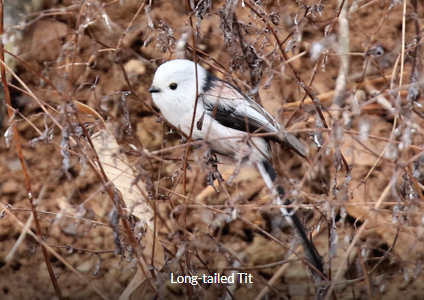
After the cranes had all emerged and assembled in the fields all around we took a walk through the adjacent fields which are always full of birds. Small groups of Rustic Buntings flitted in and out of the bushes with a few Naumann’s Thrushes perched on treetops. Eastern Great Tits and Oriental Greenfinches were much in evidence but real excitement was provided by a Siberian Accentor moving through the reeds. It was not easy to get onto for much of the time but eventually most of us got a good view before it flew off into the distance. As we walked along we were able to enjoy more great views of both species of cranes as they flew overhead and, in a couple of cases, landed in nearby fields. However, perhaps the most memorable birds of our short walk were a small group of Long-tailed Tits of the white-headed caudatus race. While this species was not a lifer for most of the group it is undeniable that this particular version of Long-tailed Tit is quite a special bird and if we were to have a vote for the cutest bird of the trip, this would be a likely winner.
The small areas of hillside woodland here held a nice collection of birds including Great Spotted Woodpecker, several Hawfinches, at least one Pallas’s Rosefinch and a smattering of Oriental Greenfinches too, with most of these seed-eating birds feeding in the rice stubble of the adjacent fields. As always, our walk around this area, coupled by the crane spectacular, made for a really satisfying birding session but we had something else that had the potential to be spectacular too a little further away so we made our way back to the vehicles, via a visit to the heated toilets, and made a twenty minute drive to another area.
This time Nial had taken us to an area that had been developed for visitors to observe birds at close quarters with a large hide placed on a river bank overlooking a wide, shallow river that was absolutely covered in birds; cranes and wildfowl in numbers that looked like somebody had just turned up in a fleet of trucks and dumped them all into the water.
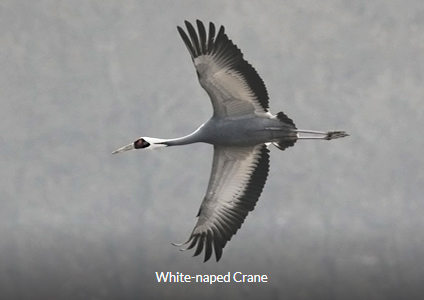
Large numbers of White-naped Cranes were feeding in the shallows, joined by smaller groups of Red-crowned Cranes giving us superb views of both species and giving the photographers among us exactly what we wanted. Surrounded by masses of Eastern Spotbilled Ducks, Greater White-fronted Geese and Mallard the cranes gave us prolonged views of them feeding, preening and interacting with one another before something spooked them into taking flight, before circling and reforming as a flock in front of us again. Someone said it may have been an Amur Leopard Cat, which got us all searching through the reeds, but others among us saw a White-tailed Eagle fly through.
Among the commoner ducks and geese we were able to pick out at least one Mandarin Duck and around twenty Baikal Teal, not the numbers that we would expect to see later in the trip but a great opportunity to see them at close range and really appreciate the beautiful plumage of the males; this really is one of Eurasia’s most beautiful ducks. There were a few Northern Pintail and Eurasian teal too but there would be better views of those later in the trip so after spending an hour or so admiring the spectacle in front of us we decided to move along to the spot we had allocated as our lunch stop where, of course, there would be more birds for us too. However, along the way we would come across a couple of Cinereous Vultures soaring close overhead followed by a White-tailed Eagle in a field eating a recently captured duck; probably the bird that disturbed the group of cranes we had been watching.
Gunnam Dam has provided a good place to stop for our picnic lunch over the last few tours and it did so again on this occasion as we were able to connect with the resident group of Hill Pigeons that have adopted the dam as a substitute for a rocky cliff. While we ate our sandwiches a small group of Cinereous Vultures soared nearby as well as an Eastern Buzzard with small numbers of Red-crowned and White-naped Cranes feeding in the shallows of the river. A flock of Goosander were also present in the river and a postdigestive promenade produced primarily preseen passerines particularly Yellow-throated Bunting, Daurian Redstart, Marsh Tit, Oriental Greenfinch, Rustic Bunting and Eastern Great Tit. A couple of flypast Buff-bellied Pipits were new but there would be proper views of those later along the route. All of these are lovely birds but Nial had something special up his sleeve for us elsewhere so we drove along a riverside track to a “secret” spot along the river which was quiet and undisturbed. Before getting there we found a nice Merlin sitting on overhead wires and a nice male Hen Harrier hunting over some fields but it was the group of four Scaly-sided Mergansers at our undisturbed river location that got everyone excited. This endangered species is always one of the most anticipated birds of this South Korea winter birding tour so it was great to be able to watch them so early in the trip this time. We did have another location for them later in the tour but it is always nice to get rare birds in the bag as early as possible on any birding trip.
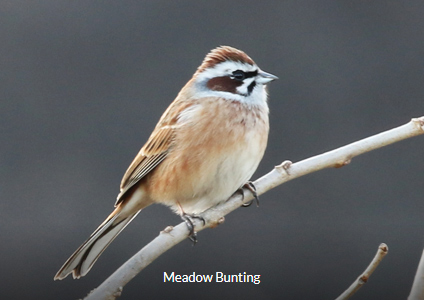
Our last birding stop of the day was close to a road bridge at the Hantangang river not far from our accommodation in Jeongok, where there was a riverine habitat restoration project. While we saw plenty of the birds that we were becoming familiar with by this point this spot was really a take of three species. The first of these was seen quickly, flitting along the water’s edge and perching on mid-river rocks; Japanese Wagtail. Three of these striking regional specialities performed nicely for us, coming fairly close at some points looking at their best in the later afternoon light. While we were looking at these special birds Nial found the next key species sitting on some mid-river shingle bars: Long-billed Plover. At first they were tricky to see, blending in with the tan-coloured stones and looking into the sun, but moving a little to get the light behind us we were able to get nice views of two of these regionally restricted waders.
With the sun beginning to sink below the nearby hills there was one more species for us to enjoy having heard the soft call of Meadow Buntings coming from some nearby reeds and scrub we slowly walked towards the sound before spotting a small group of them sitting in the vegetation. These are fairly numerous birds in South Korea in winter, in the right habitat, but with their smart plumage they are always birds that are highly appreciated. With this final, enjoyable sighting we headed off to a nearby restaurant to experience an authentic Korean barbecue with accompanying authentic Korean beverages.
Day 4; 6th January – Forest Trail – Ayajin Harbour
This morning would give us something a little different by taking a walk along a trail through some forested hills in search of Hazel Grouse. At first the trail was in the shade, cold, rather dark and slippery compacted snow but as the track wound around the hills things brightened up and walking became easier. Birds were a bit thin on the ground with only a small group of tits including a small party of Long-tailed Tits and a smart Varied Tit. However, while,watching these we picked up a Siberian Accentor in the undergrowth. Again, it was a little tricky for everyone to get onto it but eventually everyone who had not had a good view previously managed to see this one well. It is always nice to ensure that everyone in the group has seen a key species like this properly having had some people miss it on the first opportunity.
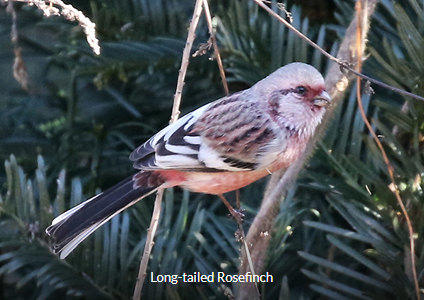
We spent a lot of time standing quietly, listening for the soft whistle of Hazel Grouse, hearing a couple of birds but neither of which were close enough for us to spot. In the meantime a party of Eurasian Jays entertained us in the treetops and another Japanese Pygmy Woodpecker as well as a Eurasian Nuthatch did their best to distract us from our quarry. Eventually we detected a Hazel Grouse calling further up the track and although we edged closer very slowly and quietly we were worried that we would scare it away. With the call coming from close by both myself and Nial spotted a male Hazel Grouse calling from a fallen log, just about twenty feet away but as we tried to point it out to the group it flew through the forest in front of us and although we tried for the next hour or so it just got further and further away. With time management in mind we decided that we had spent enough time on this bird, just a little more luck was needed but as we headed back down the track a pair of Long-tailed Rosefinches delighted us as they danced around in some trackside seeding grasses. While watching these we also noticed a Bullfinch and as we were walking away Lee spotted a really good consolation prize in the form of four Japanese Grosbeaks perched on top of some nearby trees.
Although we had not obtained good views of our target species our efforts had been rewarded with the Japanese Grosbeaks which were birds that we had not anticipated seeing on the tour at all while on our way out we came across a large flock of garrulous Azure-winged Magpies bouncing around in some roadside woodland. Stopping to enjoy these entertaining birds we got lucky with a really fabulous male Long-tailed Rosefinch feeding in a seeding bush right next to the vehicles. Sometimes you make your own luck by spending time in the right habitat.
With a fairly long journey ahead of us we got ourselves onto the road, stopping for lunch along the way, eventually arriving on the east coast, at Ayajin Harbour, in time to spend an hour and a half enjoying our first coastal birds. The harbour and adjacent beach at Ayajin is always a good place to get close views of a variety of the commoner gulls and coastal birds. One of the highlights here, though, is the splendid Harlequin Duck and this year was no exception with a group of five swimming in the bay, being wonderfully illuminated by some late afternoon sunshine. The gull-lovers among us were able to get their fill of Black-tailed Gull and Vega Gull here with plenty of each loafing around on the beach, the harbour walls and nearby rocks with an introduction to what was a much anticipated species for many: Slaty-backed Gull. While this large gull would become a familiar sight over the next few days it is always nice to see the first! A couple of Glaucous Gulls were a nice sight too, the snowy white wings of the adults standing out from the crowd of other gulls.
A massive flotilla of Red-breasted Mergansers numbered at least two hundred birds with many of them very close to the beach allowing us to enjoy them to the full but with a smaller number of Pelagic Cormorants mixed in among them they played second fiddle to what was a new bird for many in our group. A little bit of seawatching turned up our first Black-throated and Red-throated Divers of the trip with a few distant alcids to create some excitement. After a little while we were able to locate a group of three Rhinoceros Auklets which were close enough to see well through the telescopes as well as more distant Ancient Murrelet that would leave us anticipating better views that would come later. With the clock ticking a Peregrine Falcon flew over to close proceedings before we made the short drive northwards up the coast to our much-loved accommodation at Mr Shin’s Guesthouse and another enjoyable dinner in a nearby restaurant.
Day 5; 7th January – Daejin Coast, Geonbongsa Temple & Geojin Headland
The plan was to do a little seawatching from the roof of Mr Shin’s when there are often the largest numbers of birds in the bay before heading downstairs to have breakfast. There were, indeed, large numbers of birds in the bay, in particular a movement of at least 1500 Pelagic Cormorants was notable, but many of the species were a little too distant to enjoy properly. However, the vantage point served its purpose when Lee and Nial spotted a good-sized group of mixed Scoters just off of a headland a little to the south. We could see that there were both Stejneger’s and Black Scoters there but this was hardly the way for people to get their first views so I decided that we should all get down to the cars as fast as possible and quickly drive to the headland from where we would be able to get much closer views with better light too. This policy worked perfectly as within ten minutes we were watching a flock of at least 44 Stejneger’s Scoter through our telescopes at fairly close range with the early morning sunlight on our backs; I love it when a plan comes together!
With this scarce species in the bag we also turned our attention to a group of 27 Black Scoters which, interestingly, were all males and obtain some good views of around ten Pacific Divers among the numerous Black-throated Divers. The early morning sunlight displayed Harlequin Ducks and Common Goldeneye at their best as well as giving us the opportunity to show some in the group the difference between Red-necked Grebe and Great Crested Grebe in winter plumage. Indeed, many of the Red-necked Grebes were very close to the shore as were a few Black-necked Grebes and a small number of Slavonian Grebes giving us a grebe masterclass. All of these birds on the water were fun but our attention was also diverted to the trees behind us where a flock of around 20 Siskin were feeding on seeding trees with Coal Tit, Japanese Pygmy Woodpecker, Goldcrest and a Daurian Redstart also passing through.
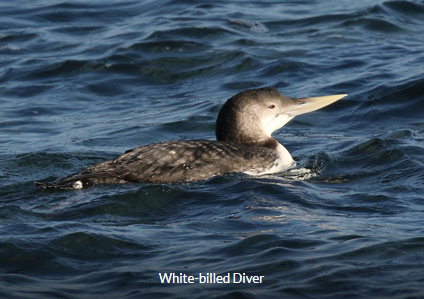
Although we could have spent much longer here it was important to have some much-needed breakfast so we headed the short distance back to our guesthouse where we had our breakfast overlooking the bay; always a lovely experience on this tour. With breakfast completed some of us went back to sea watching from the front deck while others refreshed themselves. Lee and I noticed that a small number of Ancient Murrelets had been getting progressively closer and heading towards the harbour and when they disappeared towards the harbour just as everyone was ready to look at them we assembled for a short walk along the seafront towards Daejin Harbour. Some offshore rocks along here always provide fine views of Pelagic Cormorant perched, drying its wings and on this visit we also found a couple of Temminck’s Cormorant, a somewhat esoteric bird but at this close range we were able to study the fine details that separate this species from Great Cormorant. These, however, were completely eclipsed by a bird that was spotted within a few feet of the seafront; a superb White-billed Diver, a real surprise!
Gulls in the harbour are always close, enabling us to get good views with Black-tailed, Common, Vega and Slaty-backed all being numerous. However, we were also able to study our first Hueglin’s (taimyrensis) Gulls and compare them to surrounding species before Rod found an interesting gull on a rock. Closer scrutiny and moving to obtain better light and narrow the range confirmed that it was a Glaucous-winged Gull, a bird that is very scarce although annual along South Korea’s east coast. A small flotilla of Greater Scaup emerged from behind some fishing boats but it was a pair of Ancient Murrelets in the harbour that really grabbed everyone’s attention. Having seen this bird poorly the previous day we were keen to ensure everyone got a good view here and over the course of the next half an hour a small number of these cute alcids were fishing in the harbour, coming fairly close at some points and performing in great light for excellent ‘scope views for longer periods, incoming fishing boats driving them ever closer to us. This concluded a great morning’s birding with our plan being to move on to an inland temple where we had a couple of key species to look for.
After a short drive we started to pass through rice fields with scrubby ditches within them where Chinese Grey Shrike had been recently seen. Stopping to scan likely posts and other perches we were coming up with nothing until Hilary called out that she could see something pale, perched on a bush. It turned out to be the shrike that we were looking for; good spotting! We were able to get some great views of this ghostly shrike allowing the photographers among us to get some very nice shots. This is a bird that is present in small numbers in winter in South Korea so it was great to catch up with it here. Further along we arrived at Geonbongsa temple, nestled in the woodland, covered in a layer of fresh snow where we hoped to locate Brown Dipper in the streams. Although we found a nice collection of birds in Goldcrest, Eurasian Nuthatch, Japanese Pygmy Woodpecker, Coal Tit, Meadow Bunting, Oriental Greenfinch and a Siberian Accentor we did not get a sniff of the Dipper, meaning that we would have to look for it at another reliable spot later in the trip.
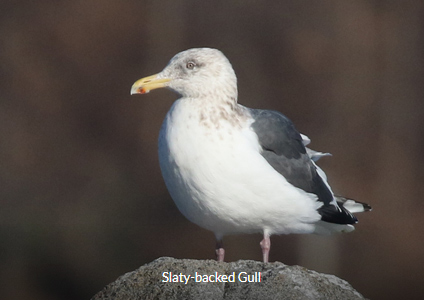
Heading back towards the coast we stopped at a convenience store for some lunch before arriving at Geojin headland, an excellent place to scan the sea for rarer seabirds. Over the course of the remainder of the afternoon we stopped at various spots along the coast as we travelled northwards back along the coastal road towards our accommodation at Daejin. By this time there was a bit of a breeze blowing towards us and much of the area we were birding in was now shaded, making things much colder than earlier in the day. However, we were able to see a nice selection of many of the birds we had seen earlier, including improved views of a few of them. Late in the day we found a few more Stejneger’s Scoter just offshore for some more good views of this key target bird.
Our last stop saw most of us thinking of a warm shower before Nial spotted a distant Spectacled Guillemot. Everyone rushed out to look through the telescopes but it was tough to refind it at the distance it had been spotted at. We did relocate it and a few people managed to get a “tickable” view but in the end the cold got the better of us so we went back to clean up and prepare for dinner at a local restaurant, a short walk away to celebrate another excellent day with more great birds.
Day 6; 8th January – Namdaecheon River, Gangneung – Tabaeksan
With quite a long journey ahead of us on this day we opted for leaving after having breakfast, once again looking out onto the bay as it became light. Packing our things into the vehicles and saying goodbye to Mr Shin we started on our journey south to the Namdaecheon river estuary on the southern outskirts of the city of Gangneung. A nice sunny morning greeted us here with one of the first birds being Long-tailed Rosefinch in the low vegetation close to where we had parked. On the river were a nice selection of the commoner Eurasian ducks including our first Northern Shoveler of the trip and at least four Smew with a male shining in the bright sunlight. Northern Lapwings are always splendid birds and here we were able to enjoy them at close range with their iridescent colours illuminated. Here we were also able to get to grips with Mongolian Gulls properly with the first winter birds really distinctive and some adults nearby for size and shape comparison with the Vega Gulls. This was also the first time we ran into Black-headed Gulls, although it would not be the last, but a perched White-tailed Eagle basking in the morning sunshine was possibly the finest observation.
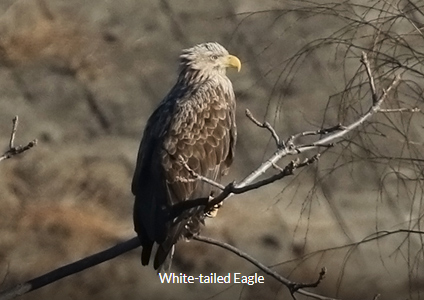
A nice collection of birds to start the day with but no sign of anything rarer although we did get nice views of Bull-headed Shrike and our first Eurasian Hoopoe of the tour; a bird which looks out of place in the snow. With a lot of travelling ahead of us we decided to head towards Tabeksan to search for Asian Rosy Finch in the mountains. On our way back to the vehicles we added a trio of Warbling White-eyes to our expanding South Korean bird list.
Our usual modus operandi at Tabaeksan is to drive slowly around access roads on the mountain in search of a flock of Rosy Finches but compacted snow had turned into icy patches that stopped our progress by car so we had to search on foot instead, after having a picnic lunch. While this is a great location to find this hard-to-see bird there is never very much else to see up here given how harsh the environment is. On this occasion things were not especially cold so we were able to cover a lot of ground and as we waited in one of the more reliable spots we spotted a flock of small passerines in flight. This bouncing flock of about 150 Asian Rosy Finches came flying in and landed on some small, spiky bushes allowing me to get them in the ‘scope for those people standing close to me, however, as is their nature, they quickly took off again and flew directly towards us, swirling around our heads before circling around several times then disappearing over the ridge of the hills. Despite much effort to refind them over the next hour or so we could not relocate the flock and eventually the decision was to leave to give us the time to stop along the way to search for Brown Dipper on some mountain streams.
Over the previous couple of trips we had found a couple of reliable spots for Brown Dipper along the way and at our first spot we found one rather quickly. Unfortunately, part of the group had disappeared into the toilet so we had a search to refind the bird. I managed to do that but it flew straight past everybody so we decided to move along to our second location where longer views along the river make for easier viewing. So it proved. As soon as we parked the vehicles we found our Brown Dipper but again it flew off downstream. This time, though, we refound it and were able to spend time watching it bob up and down on the rocks and swim around feeding in the icy water. All that then remained was to continue our journey to our hotel and then go to one of our favourite restaurants where the ladies who run it always really look after us and serve some delicious food.
Day 7; 9th January – Pohang Coast – Pohang River – Nakdong Estuary
Leaving our hotel we made the drive towards the coast, a little south of Pohang which is usually a reliable site for Russet Sparrow; a very localised bird in South Korea. Things were cold indeed so we drove around the narrow access roads that run between small fields and between houses in a small village. The first lap came up with a couple of false moments of excitement with Eurasian Tree Sparrow and Oriental Greenfinch but the second lap turned up the goods and we were able to get out and watch a flock of around twenty Russet Sparrows as they fed in a stubble field and took periods of rest in nearby trees. The males of this species are an under-rated bird in my opinion but they were fully appreciated by everyone in the group and when they disappeared towards a thick copse we decided to take a look along the rocky coast just a few hundred metres away.
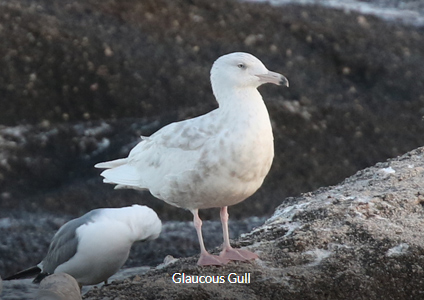
Plenty of the commoner gulls were hanging out on the rocks along with a smart Glaucous Gull. However, there were quite a few Hueglin’s (taimyrensis) Gulls too and most people were keen to really get to grips with this taxon. While doing so the wind chilled us and a flock of around twenty five Sanderling came flying in to perform their water’s edge dance and a Slavonian Grebe came in close to give us our best views yet. While the gull-watching group enjoyed the glut of taimyrensis I took a look into the nearby harbour and while there were no seabirds sheltering within it a Blue Rockthrush came swooping in to land on the wall when Phil, Hilary and I had more or less given up on finding one. This was the trigger for everyone to come back to the vehicles, see the Blue Rockthrush and then move on to the next site.
Our next location was just under an hour away and was a nice stretch of a wide, reed-fringed river with gravel bars and muddy areas within it; a real mix of riverine microhabitats with farmland either side. A month or so earlier a Crested Ibis had been seen here but despite much searching we were not able to relocate it however, there were plenty of other really good birds to see and our time here was very enjoyable indeed. Starting with the best view over the widest area of river we were able to pick out a pair of Falcated Duck among the big numbers of assorted wildfowl. A handful of Baikal Teal were among them too with a small number of Tundra Bean Geese with a flock of fifty or so Taiga Bean Geese giving us a nice comparison of these two similar species. While watching the ducks and geese the call of some buntings could be heard in the reeds in front of us and this included our first Pallas’s Reed Bunting which conveniently sat on top of a reed for a good length of time allowing everyone to see it through the telescopes. A few more of these smart little buntings popped out of the reeds shortly after spotting the first one allowing us to get more familiar with them. Buff-bellied Pipits periodically flew past calling but never settling and a hunting Eurasian Sparrowhawk may have been responsible for that.
Driving along the track that went alongside the river we scanned the river as we went but we stopped when Lee told us over the radio that they had spotted some grosbeaks from his vehicle. Heading back in the first car we all got together to refind a group of Chinese Grosbeaks. This actually took some time with them disappearing into the distance before reappearing right next to us but pantomime “they are behind you” moments aside we all eventually got good views of this really attractive bird with a group of at least twelve birds present, feeding in the reeds. With stomachs rumbling it was time to continue our journey with a lunchtime stop some distance away and the afternoon already creeping along; sometimes the birds make us lose track of time!
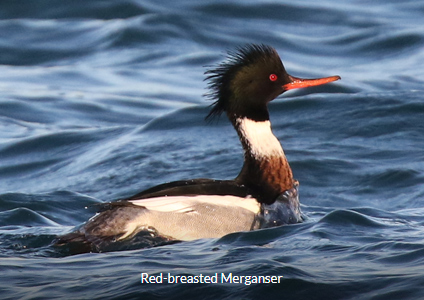
Eventually, after lunch and completing the remainder of our journey we arrived at the Nakdong estuary in Busan timing things right for the tide to start turning and make the birds congregate. Whooper Swans, Red-breasted Mergansers, Black-necked Grebes and large numbers of Black-tailed Gulls were obvious and all effort went into scanning for Relict Gull as we felt that this was our big chance for this rare bird. We added Eurasian Curlew and Dunlin to our lists here but the first exciting bird we found was a pair of Swan Geese, shovelling in the mud at some distance. Distant Common Gulls deserved close scrutiny, a couple of times creating a level of optimism that was then crushed before the search continued as the tide came in and gulls collected on the remaining areas of mud close by. It felt like a Relict Gull was about to fly in at any time but somehow this did not happen, even though Nial had seen this species here recently and as time went by the mud disappeared completely and birds dispersed. Well, not all birds are easy and there would be other chances for this much-desired species later in the trip so off we went the short distance to our nice hotel – French Code – with a very welcoming host. After a nice warming shower we walked just around the corner to a little restaurant where the lady who runs it helped us order and generally looked after us with side dishes and drinks to end another good day of birding.
Day 8; 10th January – Junam Reservoir – Nakdong Estuary
Junam Reservoir is always my favourite location for birding on this tour; a location with a wide variety of species in high abundance and usually plenty of good views of birds, not to mention the wonderful flocks of cranes. Arriving in the early morning we had plenty of time to enjoy birds here, starting with an area that is secluded and containing a good mixture of farmland plots, woodland and lakeside vegetation. Greeting us on arrival were a graceful group of Eurasian Spoonbills feeding in the shallows very close to where we had parked. Good numbers of Whooper Swans were also present along with a wide selection of the commoner wildfowl and as we were enjoying the spoonbills a Common Kingfisher flew past and landed on a branch overhanging the water. Our walk took us through this mixed habitat where a few Yellow-throated Buntings were feeding alongside several Rustic Buntings but Nial picked out the call of Black-faced Bunting. A nice male came out of the undergrowth for us to appreciate followed by a female that was extremely confiding, feeding on seeding grasses within a few metres of the whole group.
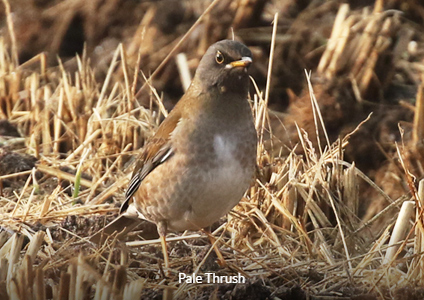
Further along a group of Dusky Thrushes were found feeding in an orchard and we were able to watch these crisp-looking birds at length as they were joined by groups of White-cheeked Starlings. However, nice as these birds were they were then eclipsed by the arrival of a Pale Thrush, landing in a nearby twiggy tree before moving onto a stubble field where most of us were able to watch it feed, before it headed back into hiding in thick vegetation. Groups of chattering Vinous-throated Parrotbills piled out of thickets from all around with Bull-headed Shrike surveying the scene, ready to pounce for a meal. A couple of Common Starlings were seen in flight but with time management on our mind we decided to move on to the other side of the lake to see what we could find.
Viewing areas on a raised bank which give people the ability to watch birds on the lake gave us large numbers of birds to scan through. Large numbers of both Greater White-fronted Geese and Taiga Bean Geese made up much of the throng but most of note were three Swan Geese among them. Although we had seen Swan Goose on the Nakdong Estuary this view was better; closer and in better light. These handsome geese are always a highly-anticipated bird on this tour and one that we almost always see here at Junam. This spot also gave us our best views of Smew with a couple of wonderful males at quite close range. This is a bird we see in moderate numbers at many sites on this tour but I can never get enough of this stunning duck; a real treat to see it like this given how scarce it can be elsewhere. Some muddy edges to the lake revealed a Common Snipe hiding within the reeds and a Green Sandpiper pottering around on a sandy spit.
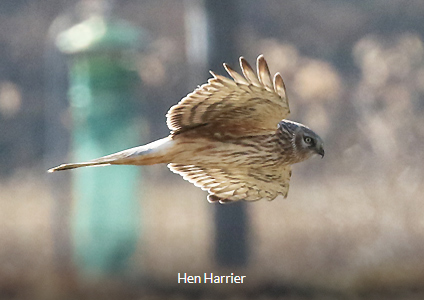
So far, so good but not far away we had an excellent spot to have our picnic lunch so we drove a little further around the reservoir to some stubble fields where a local conservation organisation provides supplementary feed for wintering cranes and it was here that we could park and take in not only the sight but the sound of a flock of over five hundred cranes. This always creates a magical moment with a large number of White-naped Cranes interacting with each other, feeding, hooting, leaping and flying around making for a nice backdrop to lunch. As always, we looked carefully though the flock in search of other species with a handful of Hooded Cranes among the closely packed flock and at least two Common Cranes as well.
Spending time at this spot, enjoying the atmosphere created by the cranes also allows time for other birds to show up and in this way we were able to get very good ‘scope views of a small flock of Eurasian Skylarks and a couple of Buff-bellied Pipits as well as a flypast from a couple of Hen Harriers. Other raptors included a pair of monstrous Cinereous Vultures while Rod spotted a large eagle that turned out to be an Imperial Eagle, a really scarce bird in South Korea. Sometimes just standing in a good spot leads to a lot of bird sightings and so it was here, the cranes being the highlight but other species included a Hoopoe, a few Bull-headed Shrikes, small groups of Greater White-fronted Geese and a gang of Vinous-throated Parrotbills emerging right next to our lunch spot.
Moving on from here a short walk at a different lake turned up a Japanese Pygmy Woodpecker and a few Baikal Teal but we decided that the best way to spend the late afternoon at the Nakdong Estuary where we would be able to get good views of a wide variety of waterbirds and another chance at finding the much-wanted Relict Gull. After a drive of just under an hour we started a late afternoon stroll along the waterfront, very close to our hotel, with the light coming from behind us to give us the best opportunity of spotting something good. A bank of trees here seem to always harbour the lovely Yellow-bellied Tit so we started by searching for these, taking Nial only a matter of minutes to locate at least two of these little birds. When we first started leading winter birding tour to South Korea this was a really rare wintering bird but now it seems to have colonised the Korean peninsula, being regular in winter and breeding confirmed; a nice addition to our trips now. While we were enjoying these birds Lee called us to the waterside where he had found a superb adult Steller’s Sea Eagle sitting on the exposed mudflats. Over the course of the rest of the afternoon we were able to watch this bird upsetting the surrounding wildfowl and armies of Great Cormorants as it moved around, eventually moving on to perch in a tree. One Steller’s Sea Eagle is wonderful of course but here we saw three, something that we had hoped for when coming to this location at this time of the day. Flocks of Black Kites came in to harass the eagles from time to time while other raptors included Hen Harrier, Eastern Buzzard, White-tailed Eagle and Cinereous Vulture.
Scanning the mudflats revealed most of the birds seen on the previous day, including two distant Swan Geese and a few Ospreys perched on posts. Eurasian Curlews and Dunlin were this time accompanied by the most distant of Pied Avocets; these ones really pushed birding to its limits but even at this extreme distance the distinctive colours and shape of the avocets were obvious. Gulls were abundant here and by now everyone was familiar with Black-tailed Gull, Common Gull, Black-headed Gull and Slaty-backed Gull, all present in a variety of numbers. Many in our group were very pleased to be able to pick out first winter Mongolian Gulls too and the tern-like flight of Saunders’s Gulls as they arrived to pick food off of the exposed mud was something everyone could recognise too. As these graceful birds moved along, taking off, bouncing along, alighting on the mud to pick off a prey item and then taking off again to repeat the action Nial noticed something special; Relict Gull! This bird by now was one of the most wanted by all members and even though the distance was really on the limit we could all see the distinctive shape, dark bill and pale upperparts in comparison to surrounding Common and Black-headed Gulls, particularly as the light improved. This success allowed us to relax and enjoy whatever else we could see; Eurasian Wigeon, Northern Pintail, Whooper Swan, Greater Scaup and Common Goldeneye all at very close range were nice but the final act of a great show was one of the Steller’s Sea Eagles flying past towards its roosting site. We did likewise before walking around the corner to the restaurant run by the friendly and helpful lady.
Day 9; 11th January – Merganser Creek – Suncheon Bay
Although we had already seen it we decided that it was worth trying to get better views of Scaly-sided Merganser so our first stop of the day was at a reliable site on a river, a small detour from our onward journey for the day. Stopping at a spot where the river takes a quiet bend beyond a small town we immediately located our target, Scaly-breasted Mergansers sitting on some rocks less than 100 metres away, giving us fantastic views of this globally endangered birds. We were able to watch two males and a female cruising around, fishing and preening for as long as we liked. Eventually we decided it was time to leave them undisturbed and we took a moment to look at a couple of Olive-backed Pipits sitting on overhead wires near the vehicles before a very short drive to another stretch of the same river where we were able to find a small group of Mandarin Ducks. Most people are familiar with this bird from wildfowl collections or feral populations but it is always nice to see “real” wild ones in Asia, particularly given how spectacular the males are. Lee found a photogenic Bull-headed Shrike but while we were appreciating it someone noticed some movement in the river that turned out to be a couple of Eurasian Otters playing around in the shallows. Having enjoyed a successful morning it was time to continue our onward journey to Suncheon Bay.
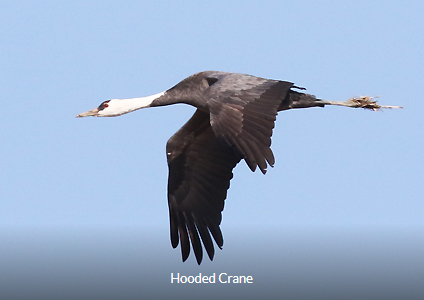
Suncheon Bay is another area where supplementary feeding of cranes occurs, this time the main species being Hooded Crane. There is a particular spot at Suncheon Bay which takes us right into the feeding area so this is the direction in which we headed directly to be welcomed by a huge conglomeration of Hooded Cranes; thousands of them feeding in the fields with small parties coming in and out over our heads. The constant contact calls created quite a soundscape while we had our sandwiches in the sunshine. Groups of Greater White-fronted Geese, Tundra Bean Geese and Taiga Bean Geese joined the cranes in guzzling up the food in the stubble fields with around fifteen Cinereous Vultures lurking around, looking massive both in the air and on the ground.
Nearby in reedy ditches small passerines were flittering around. Most of them were Eurasian Tree Sparrows but there was also a nice male Daurian Redstart and a couple of Pallas’s Reed Buntings gave us some really great views.
This is often a good area for raptors and the conditions obviously suddenly became perfect for them to fly with many vultures taking off, Eastern Buzzard, a few Hen Harriers, a White-tailed Eagle and then a couple of Upland Buzzards soaring close by. While appreciating these the call went up that there was also a Rough-legged Buzzard perched on a post a few hundred metres away; a real raptor half hour and a couple of new species for our list. While most of us were photographing raptors in flight Nial had been counting the cranes with a total of 3200 birds being present and among them, a single Common Crane. An impressive flock indeed.
A short drive took us to another area of Suncheon Bay where Nial had recently seen a good variety of Buntings. Walking around some weedy fields intersected by reedy ditches the habitat looked good particularly when we found a few Rustic Buntings and Yellow-throated Buntings. The call of Little Bunting was detected from some thick vegetation and when it flew across a ditch most of us did see it for a short period of time. Next was the call of Chestnut-eared Bunting, the bird we were looking for here, but although it persistently called it stubbornly stayed in the undergrowth until a farmer walked along. The bird flew out and landed in an equally thick area of undergrowth. This happened several times with the bird being seen in flight by all but only a few of us got to see it perched for a very brief moment. A Black-faced Bunting was more obliging but eventually time ran out and we started our journey towards our hotel in Gunsan followed by dinner in another of our favourite restaurants along the route.
Day 10; 12th January – Neung Je Reservoir – Guem River & Coast
We had a lot planned for this day with a wide variety of habitats in the area and a lot of good birds to look for. We began by leaving early and getting to Neung Je Reservoir a little after first light. On the previous year there were vast numbers of birds here but somehow things were a little underwhelming this year. Small numbers of wildfowl were present on the lake, including a few Gadwall for those who had not seen them earlier in the tour, but the hoped for flocks of Rooks did not materialize so, instead, we went for a drive around the nearby fields to see if we could locate the large flocks that we usually see. It seemed that the mild weather meant that birds were not being forced into making large flocks but we did locate a group of a few Hundred Rooks feeding in a field. As we stopped they began to lift off and perch on roadside wires and this is when we had the opportunity to look for our main target: Daurian Jackdaw. Small numbers of these attractive corvids usually join flocks of Rooks in this area in winter and remembering that Nial had told me on previous trips the Daurian Jackdaws tend to perch right next to the supports of the wires that is the first place I looked and indeed, there was a juvenile Daurian Jackdaw. We managed to get this bird in the ‘scope for everyone and as the birds shifted around we spotted another three, one of which was almost in adult plumage. Well, we did not see the nice black and white version of the full adult but we all agreed that this was better than missing the birds altogether so when they flew away we moved on towards the Guem River.
By the time we reached the river it was a lovely sunny day so we were hoping for good views of large numbers of Baikal Teal on the river. What we did not expect was that they would be sitting right in front of us, less than one hundred metres away and that there would be as many as 800,000 of them! Nial told us that the world population of Baikal Teal fluctuates quite a lot over the years and since wintering conditions in South Korea have been favourable the population has grown. For sure, this was the biggest flock seen in the years that we have been doing this winter birding tour and it was a real treat to see so many of them at such close range and in perfect light. There was the odd interloping duck of another species but the seething mass of birds was largely Baikal Teal and we were able to witness them moving along as a rolling flock and photograph them from the river bank. Many of us could have stayed and watched this spectacle for hours but timing was important for some other species later and we would be able to revisit the Baikal Teal flock later in the day.
Just over the other side of the river we went to a sort of wooded park with a trail uphill to an observation tower. The walk up was fairly uneventful with Marsh Tits, Eastern Great Tits and a few Varied Tits in evidence. We reached the tower having seen little else, although a Great Spotted Woodpecker tricked us into thinking it was something else for a while. From the tower some people spotted a group of Common Crossbills in flight that landed on a distant and backlit tree. Not a great view but we then followed a trail towards where we had seen them and just when we thought they had eluded us, we spotted them in some nearby pine trees, feeding on the seeds in pine cones, doing exactly what their bills are adapted to do. These are always great birds so we took our time with them before continuing back down the hill. We waited, listening for the call of White-backed Woodpecker but this species would have to wait until much later in the tour but we were treated to a lovely display from a group up to ten Yellow-bellied Tits before driving around the corner to a convenience store where we could eat our lunch in the warm sunshine.
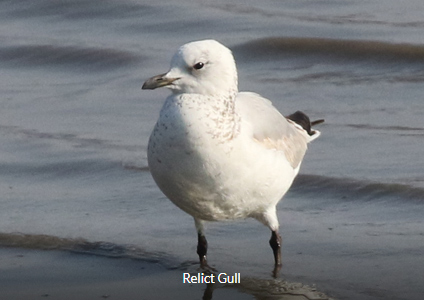
After lunch our next stop was part of the Guem estuary, a spot where we have seen lots of good birds in the past and so it would prove again. As we parked we spotted the Common Greenshank that we always seem to add to the trip list here and a couple of Long-billed Plovers were extremely close so we parked and sneaked around to take some point-blank photographs of them, politely posing for us. There were lots of great views of wildfowl here, resplendent in the perfect light but Nial came along telling us that we should get back in the vehicles and move to the next bay. He had seen large numbers of Saunders’s Gulls heading into another bay as the tide rapidly came in so we sped around there in time to see big numbers of gulls gathering on the rapidly declining patches of mud adjacent to a small harbour. Quickly scanning through them we were getting awesome views of Saunders’s Gulls before Nial announced that he had a Relict Gull! It was only a short distance away but in poor light so after we had all seen the bird we rushed around to the other side of the area from where we had superb light and could enjoy a smart Relict Gull at a distance of around 30 metres and in absolutely perfect sunlight. What a moment!
We spent the remainder of the afternoon cruising around looking through flocks of geese, in search of rare goose species. However, we drew a blank with that so headed back to the Baikal Teal flock for the late afternoon where lots of other bird-lovers had also gathered awaiting the show. As the sun began to set the Baikal Teal flock began to take off and wheel around, creating amazing patterns in the sky. The sight was matched by the sound of 800,000 pairs of wings as the orange sky created a backdrop to the mass of birds in movement together in some sort of aerial ballet. After such a performance and a day of good birds we had plenty to talk about over dinner.
Day 11; 13th January – Osik Park – Seosan
Having had such a good day yesterday and having seen most of our hoped for targets we planned today to try and find a last missing few. Osik Park is literally just around the corner from the hotel so that is where we started finding the main species we hoped for within moments of getting out of the vehicles: Grey-headed Woodpecker. The plaintive call of this woodpecker alerted us to its presence in the pines close to us and it came in to show itself shortly after hearing it. Taking a walk through the park the mild weather meant that bird abundance was low although we saw good numbers of Eurasian Siskins feeding in the trees. Much of the walk was fruitless but as so often happens once we were almost back at the vehicles we found a few Common Crossbills, Olive-backed Pipits and a flock of noisy Azure-winged Magpies to brighten up the morning. At another spot close by we heard a Japanese Bush Warbler but such was the density and abundance of thick undergrowth all efforts to see it failed. With just one more major target species to see we wanted to ensure that we had enough time to find it so we all got into the vehicles to head towards Seosan.
Arriving shortly after stopping for lunch along the way we got to the very large reclamation area of Seosan an area of fields intersected by ditches with a river flowing through it; a very big area to cover to try and find a few Oriental Storks that were known to be wintering in the area. However, Nial had a tip off as to where we should be looking and although we followed the directions correctly there was no immediate sign of these endangered birds. Rather than search around aimlessly we chose a bridge over a large ditch that was a little raised over the winder area so that we could scan and this plan turned up the goods with a couple of Oriental Storks foraging in some wet fields. As we were watching these birds we were treated to a flypast by another stork, followed by another and a slow trickle of birds flying close by us so that we could fully appreciate not only the striking black and white plumage but their massive size; much bigger than the similar-looking White Stork. As we watched at least fifteen of these magnificent birds flying off into the distance we also noticed a cloud of Cinereous Vultures circling as well as a flock of Lapland Buntings flying around in the distance.
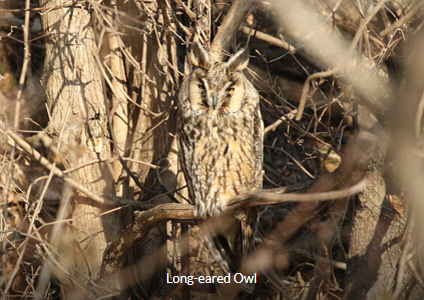
Taking a walk around a large reed bed we were able to get lots of good views of Pallas’s Reed Buntings calling from the tops of the vegetation as well as adding Common Reed Bunting to our list. However, what we were really looking for was Chinese Penduline Tit. Listening carefully we eventually picked up the call of this tiny bird before spotting a pair of them feeding on seeding reed heads, wonderful. While enjoying all of these birds a White-tailed Eagle glided in close to us and a group of around 150 Hooded Cranes were disturbed by this, revealing themselves to us.
While spending some time scanning goose flocks Nial got a call from an acquaintance letting him know of a roost of a Long-eared Owl. It did not take us long to get there and we thanked this group of birders for sharing a remarkable sighting of this fantastic bird in the late afternoon glow.
We had time for one more stop, overlooking an area of river that had some exposed mud and shingle where we found some waders including Eurasian Oystercatchers, several Kentish Plovers and a Grey Plover to add to our list. With this final flurry of birds and the setting sun, we started our short journey to our hotel in the city of Hwaseong and to enjoy change of dining at an Indian restaurant.
Day 12; 14th January – Namhansanseong – Michuhol Park
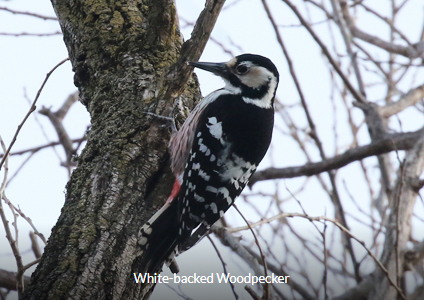
Having found all of the wetland and open country birds that we thought we could see, we decided to head to the woodland winter wonderland that is Namhansanseong for another chance at Hazel Grouse and to find White-backed Woodpecker. Arriving at around 8am things were rather overcast and cold, with the weather predicted to take a real change today in terms of precipitation and temperature. Slowly walking up the woodland trail things were a bit slippery but friendly Marsh Tits, Varied Tits and Eastern Great Tits amused us while a couple of Eurasian Jays came in to take a close look at us.
A period of standing quietly, listening for calls did not give us the sound of Hazel Grouse but we did hear the soft ‘pip” of a White-backed Woodpecker. It was hard to place where it came from until someone spotted a flash of movement and the call was repeated from a little closer. Then a moment of excitement ensued with not one, but two White-backed Woodpeckers flying in to a low tree right next to us, allowing us to watch them foraging for grubs within the tree trunks at very close range. A really good bird to get on our last day. We proceeded up a trail where we had seen Hazel Grouse on past trips but very slippery compacted snow really made things difficult. We spent quite some time playing the call of the grouse and listening but to no avail. In the end we decided that the rapidly clouding skies and dangerous trail meant that we should leave; sometimes safety is the most important thing and I was concerned that someone would have an accident. On our way out we came across a nice group of birds feeding in the leaf litter including some lovely Bramblings, a Hawfinch and a group of four colourful Bullfinches. Back at the car park it was time for some hot coffees and a last look at Azure-winged Magpies crashing around in the surrounding trees.
Our final birding site was Michuhol Park in Incheon, a short drive from our hotel. Normally we would not visit this manicured city park but there had been regular sightings of Japanese Waxwing here so it seemed like a good place to try and find that last bird. Unfortunately, the weather had other ideas with a steady stream of drizzle making bird activity very low and birding a rather soggy affair. When we found some trees with lush red berries on them, being consumed by groups of Naumann’s Thrushes our expectations rose but no matter how long we waited no waxwings turned up. Finding a shelter in which to eat our sandwiches we took a break from the rain. However, with lunch completed the rain became harder and in an overoptimistic surge of energy some of us continued our search turning up a Eurasian Treecreeper and a Goldcrest but eventually we had to accept that things were over and with the hotel less than an hour away a warm, dry couple of hours before our final dinner together was appealing to everyone.
After a shower, a change of clothes and a few hours to rest we got together for our last meal together, in a steaming warm restaurant, accompanied by a few beers and sojus to chat about the best moments of the tour, vote for the birds of the trip and say our goodbyes before our onward journeys.
Bird of the Trip
- Relict Gull
- Steller’s Sea Eagle
- Baikal Teal
- White-naped Crane
- Red-crowned Crane
Incheon: Right next to our hotel there was a small harbour with mudflats exposed at low tide, a small wooded park and a large area of reeds and scrub, backed by an urban landscape, located on the island upon which the international airport is built. This is a good spot for a variety of South Korea’s more abundant winter birds and a nice introduction to winter birding here upon arrival.
Han River Paldang: The Han is the river that runs through South Korea’s capital city Seoul and at Paldang it is wide and shallow but still with an urban landscape with the addition of a mountainous backdrop . Rocky outcrops, emergent islands and sand bars attract many birds and bankside vegetation can harbour winter passerines. Steller’s Sea Eagle is the standout bird at this location although it can also be good for Scaly-sided Merganser, Siberian Accentor, White-tailed Eagle and Mandarin Duck.
National Arboretum: A series of trails and gardens are situated within a wooded valley surrounded by rolling hills covered in mixed deciduous and coniferous trees with a small, rushing stream running through it, making this a very pleasant place to go birding. This is a particularly scenic spot if there is a covering of snow. Key species at National Arboretum include, but are not limited to, Solitary Snipe, Varied Tit and Japanese Pygmy Woodpecker.
Cheorwon: Areas of rice stubble, interesected by rivers, ditches and woodland copses provide a wide variety of habitats and birds. This area provides an excellent place to get standout views of both White-naped Crane and Red-crowned Crane in flight and on the ground feeding in the fields. Meadow Buntings can be found in reedy ditches along with Long-tailed Rosefinches and areas of water often contain a wide variety of wildfowl.
Gunnam Dam: Here the Imjim River is dammed by a flood control barrier. The river is a typical meandering, fast-flowing rocky waterway containing rocky islets andfringed with woodland, scrub and emergent vegetation. This is a good site for a wide variety of winter birds, including a variety of raptors, but Hill Pigeon is the target species here.
Hangtangang River: A wide, shallow, fast-flowing river with ricky and shingle banks close to a town where some areas are part of a restoration project. This is a reliable location for two key species; Long-billed Plover and japanese Wagtail.
Forest Trail Yeoncheon: A track through low, wooded hills that gradually winds uphill through prime habitat for the species associated with this habitat. Good for tits, winter finches and sometimes thrushes but the main target bird here is Hazel Grouse.
Ayajin Harbour: The harbour around a busy fishing village with rocky outcrops and a quiet sandy beach all of which attract a variety of coastal birds to loaf around and feed. A wide variety of gulls occur here and, in particular this is a good place to see Glaucous Gull and Harlequin Duck.
Daejin Coast: Coastline that includes fishing harbours, rocky outcrops, headlands, beaches and coastal vegetation. This is an excellent area for a variety of alcids, gulls, sea ducks, divers, cormorants and some wintering passerines.
Gangneung: A reedy river running through the outskirts of the city of Gangneung before meeting the sea. This spot attracts a surprising number of birds despite high levels of human activity nearby. In the past we have seen Long-billed Plover, Black-legged Kittiwake and Oriental Stork here.
Tabaeksan: High hills with wooded slopes and exposed tops where there are cabbage fields and a wind farm. The exposed areas are a key location for a wintering flock of Asian Rosy Finches.
Pohang Coast: A series of sandy beaches interspersed with rocky outcrops set within a large bay that can be sheltered depending on the wind deirection. Adjacent are a series of vegetable and stubble fields that attract a variety of commoner birds but the key species here is a flock of Russet Sparrows. A wide variety of coastal birds can be seen here and if the weather conditions are right anything can show up. A prime place to look for Ancient Murrelet and Stejneger’s Scoter. The harbour here attracts Blue Rockthrush.
Pohang River: A wide, meandering river through lowlands surrounded by fairly intensive farming and scruffy farmyards. The river contains many reedy areas and islets
Junam Reservoir: Several shallow tree and reed-fringed lakes set among orchards and rice fields with woodland copses dotted around the landscape. Supplementary feeding often occurs here and this site is excellent for White-naped Crane, Swan Goose, Eurasian Spoonbill, Grey-headed Woodpecker, Light-vented Bulbul, White-cheeked Starling, Falcated Duck, Baikal Teal and a good place to find a surprise or two.
Nakdong Estuary: From various places around Busan the estuary can be viewed from riverside promenades. At low tide there are large areas of mudflats with sand bars, beaches and islands covered in reeds and riverine woodland. Banks of planted trees create habitat for wintering passerines and resident species. Key birds here include Steller’s Sea Eagle, Relict Gull and Yellow-bellied Tit.
Merganser Creek: A rushing river running through and around a small town, flanked by a rocky gorge with wooded hillsides and scrubby undergrowth. As the river runs out of town the disturbance levels are greatly reduced making this a key site for Scaly-sided Merganser as well as Japanese Wagtail, Eurasian Eagle Owl and Mandarin Duck.
Suncheon Bay: An area famous in South Korea for its reed beds and for wintering Hooded Cranes which are given supplementary food on rice stubble fields which are criss-crossed by reedy ditches. This is also a good location for close up views of Cinereous Vulture and for finding rarer cranes among the flock of Hooded Cranes; Common and Sandhill Cranes often being present.
Neung Je Reservoir: A small reservoir surrounded by trees, orchards and farmland on the edge of a large village. This area is often used by large flocks of Rook usually with a few Daurian Jackdaws along for the ride. Waterfowl here often include Smew and Falcated Duck.
Osik Park Gunsan: A suburban park set on a small hill, covered in mixed woodland with grassy patches. A network of trails lead to a series of lookouts over the nearby town of Gunsan and the industrial coastal environment. Key species here include Warbling White-eye, Yellow-bellied Tit, Pale Thrush and Azure-winged Magpie.
Guem River & Coast: A wide area of farmlands and coast close to the city of Gunsan. Stubble fields, tidal creeks, a wide river and its margins plus patches of gardens/parklands provide a wide range of habitats interspersed by villages and small towns. This area is key for Swan Goose, Baikal Teal, Taiga Bean Goose and Saunders’s Gull.
Seosan: A huge area of farmland that exists as a result of a coastal reclaimation project bisected by a reedy river and surrounded by scrubby woodland. A wide variety of wintering species occur here including raptors, geese and buntings but it is also a regular site for Oriental Stork.
Namhansanseong: A network of trails runs through forested hill ridges interspersed with historical monuments. When there is snow on the ground this is a very picturesque location and a good one for various woodpeckers, Naumann’s Thrush, Varied Tit and other woodland birds.
Michuhol Park, Incheon: An arnamental city park, within Incheon , that contains many mature trees and can attract unusual wintering birds.
The sites at which each species were seen are coded as below;
- Incheon: I
- Paldang: P
- National Arboretum: NA
- Cheorwon: Ch
- Gunnam Dam: GD
- Hantangang River: HR
- Forest Trail, Yeoncheon: FT
- Ayajin Harbour: AH
- Daejin Coast: DC
- Gangneung: G
- Tabaeksan: T
- Pohang Coast: PC
- Pohang River: PR
- Junam Reservoir: JR
- Nakdong Estuary: NE
- Merganser Creek: MC
- Suncheon Bay: SB
- Neung Je Reservoir: NJ
- Osik Park Gunsan: OP
- Guem River & Coast: GRC
- Seosan: S
- Namhansanseong: NHS
- Michuhol Park, Incheon: MP
During this South Korea Winter Birding Tour we recorded 163 species.
SPECIES
ANSERIFORMES: Anatidae
Swan Goose
Taiga Bean Goose
Tundra Bean Goose
Greater White-fronted Goose
Whooper Swan
Common Shelduck
Mandarin Duck
Baikal Teal
Northern Shoveler
Gadwall
Falcated Duck
Eurasian Wigeon
Eastern Spotbilled Duck
Mallard
Northern Pintail
Eurasian Teal
Common Pochard
Tufted Duck
Greater Scaup
Harlequin Duck
Stejneger’s Scoter
Black Scoter
Common Goldeneye
Smew
Common Merganser
Red-breasted Merganser
Scaly-sided Merganser
GALLIFORMES: Phasianidae
Common Pheasant
COLUMBIFORMES: Columbidae
Feral Pigeon
Hill Pigeon
Oriental Turtle Dove
GRUIFORMES: Rallidae
Eurasian Coot
GRUIFORMES: Gruidae
White-naped Crane
Red-crowned Crane
Common Crane
Hooded Crane
PODICIPEDIFORMES: Podicipedidae
Little Grebe
Red-necked Grebe
Great Crested Grebe
Slavonian (Horned) Grebe
Black-necked (Eared) Grebe
CHARADRIIFORMES: Recurvirostridae
Pied Avocet
CHARADRIIFORMES: Haematopodidae
Eurasian Oystercatcher
CHARADRIIFORMES: Charadriidae
Northern Lapwing
Grey Plover
Long-billed Plover
Kentish Plover
CHARADRIIFORMES: Scolopacidae
Eurasian Curlew
Sanderling
Dunlin
Solitary Snipe
Common Snipe
Common Sandpiper
Green Sandpiper
Common Greenshank
CHARADRIIFORMES: Laridae
Black-headed Gull
Saunders’s Gull
Relict Gull
Black-tailed Gull
Common Gull
Glaucous Gull
Vega Gull
Mongolian Gull
Glaucous-winged Gull
Slaty-backed Gull
Heuglin’s (Taimyr) Gull
CHARADRIIFORMES: Alcidae
Rhinoceros Auklet
Spectacled Guillemot
Common Guillemot
Ancient Murrelet
GAVIIFORMES: Gaviidae
Red-throated Diver
Black-throated Diver
Pacific Diver
White-billed Diver
CICONIIFORMES: Ciconiidae
Oriental Stork
SULIFORMES: Phalacrocoracidae
Pelagic Cormorant
Great Cormorant
Temminck’s Cormorant
PELECANIFORMES: Threskiornithidae
Eurasian Spoonbill
PELECANIFORMES: Ardeidae
Grey Heron
Great Egret
Little Egret
ACCIPITRIFORMES: Pandionidae
Osprey
ACCIPITRIFORMES: Accipitridae
Cinereous Vulture
Imperial Eagle
Eurasian Sparrowhawk
Northern Goshawk
Hen Harrier
Black Kite
White-tailed Eagle
Steller’s Sea Eagle
Rough-legged Buzzard
Upland Buzzard
Eastern Buzzard
STRIGIFORMES: Strigidae
Long-eared Owl
BUCEROTIFORMES: Upupidae
Eurasian Hoopoe
CORACIIFORMES: Alcedinidae
Common Kingfisher
PICIFORMES: Picidae
Japanese Pygmy Woodpecker
Great Spotted Woodpecker
White-backed Woodpecker
Grey-headed Woodpecker
Black Woodpecker
FALCONIFORMES: Falconidae
Common Kestrel
Merlin
Peregrine Falcon
PASSERIFORMES: Laniidae
Bull-headed Shrike
Chinese Grey Shrike
PASSERIFORMES: Corvidae
Eurasian Jay
Azure-winged Magpie
Oriental Magpie
Daurian Jackdaw
(Oriental) Rook
Large-billed Crow
Large-billed Crow
PASSERIFORMES: Paridae
Coal Tit
Yellow-bellied Tit
Varied Tit
Marsh Tit
Eastern Great Tit
PASSERIFORMES: Remizidae
Chinese Penduline Tit
PASSERIFORMES: Alaudidae
(Far Eastern) Skylark
PASSERIFORMES: Pycnonotidae
Light-vented Bulbul
Brown-eared Bulbul
PASSERIFORMES: Aegithalidae
Long-tailed Tit
PASSERIFORMES: Sylvidae
Vinous-breasted Parrotbill
PASSERIFORMES: Zosteropidae
Warbling White-eye
PASSERIFORMES: Regulidae
Goldcrest
PASSERIFORMES: Sittidae
Eurasian Nuthatch
PASSERIFORMES: Certhiidae
Eurasian Treecreeper
PASSERIFORMES: Sturnidae
Common Starling
White-cheeked Starling
PASSERIFORMES: Turdidae
Pale Thrush
Naumann’s Thrush
Dusky Thrush
PASSERIFORMES: Muscicapidae
Daurian Redstart
Blue Rockthrush
PASSERIFORMES: Cinclidae
Brown Dipper
PASSERIFORMES: Passeridae
Eurasian Tree Sparrow
Russet Sparrow
PASSERIFORMES: Prunellidae
Siberian Accentor
PASSERIFORMES: Motacillidae
White Wagtail
White Wagtail
Japanese Wagtail
Olive-backed Pipit
Buff-bellied Pipit
PASSERIFORMES: Fringillidae
Brambling
Hawfinch
Chinese Grosbeak
Japanese Grosbeak
Asian Rosy Finch
Long-tailed Rosefinch
Pallas’s Rosefinch
Eurasian Bullfinch
Grey-capped Greenfinch
Common Crossbill
Eurasian Siskin
PASSERIFORMES: Emberizidae
Lapland Bunting
Chestnut-eared Bunting
Little Bunting
Meadow Bunting
Rustic Bunting
Yellow-throated Bunting
Black-faced Bunting
Pallas’s Reed Bunting
Common Reed Bunting
SCIENTIFIC NAME
Anatidae
Anser cygnoides
Anser fabalis middendorffii
Anser serrirostris serrirostris
Anser albifrons frontalis
Cygnus cygnus
Tadorna tadorna
Aix galericulata
Sibirionetta formosa
Spatula clypeata
Mareca strepera strepera
Mareca falcata
Mareca penelope
Anas zonorhyncha
Anas platyrhynchos
Anas acuta
Anas crecca
Aythya ferina
Aythya fuligula
Aythya marila nearctica
Histrionicus histrionicus
Melanitta stejnegri
Melanitta americana
Bucephala clangula clangula
Mergellus albellus
Mergus merganser orientalis
Mergus serrator
Mergus squamatus
Phasianidae
Phasianus colchicus karpowi
COLUMBIFORMES: Columbidae
Columba livia
Columba rupestris
Streptopelia orientalis orientalis
Rallidae
Fulica atra atra
Gruidae
Antigone vipio
Antigone japonensis
Grus grus
Grus monarcha
PODICIPEDIFORMES: Podicipedidae
Tachybaptus ruficollis poggei
Podiceps grisegana halballii
Podiceps cristatus cristatus
Podiceps auritusauritus
Podiceps nigricollisnigricollis
CHARADRIIFORMES: Recurvirostridae
Recurvirostra avocetta
CHARADRIIFORMES: Haematopodidae
Haemantopus ostralegus osculans
CHARADRIIFORMES: Charadriidae
Vanellus vanellus
Pluvialis squatarolas quatarola
Charadrius placidus
Anarhynchus alexandrinus
CHARADRIIFORMES: Scolopacidae
Numenius arquata orientalis
Calidris alba rupina
Calidris alpina
Gallinago solitaria japonica
Gallinago gallinago
Actitis hypoleucos
Tringa ochropus
Tringa nebularia
CHARADRIIFORMES: Laridae
Chroicocephalus ridibundus
Chroicocephalus saundersi
Ichthyaetus relictus
Larus crassirostris
Larus canus
Larus hyperboreus pallidissimus
Larus vegae
Larus mongolicus
Larus glaucescens
Larus schistisagus
Larus heuglini taimyrensis
CHARADRIIFORMES: Alcidae
Cerorhinca monocerata
Sepphus carbo
Uria aalge
Synthliboramphus antiquus
GAVIIFORMES: Gaviidae
Gavia stellata
Gavia arctica viridgularis
Gavia pacifica
Gavia adamsii
CICONIIFORMES: Ciconiidae
Ciconia boyciana
SULIFORMES: Phalacrocoracidae
Phalacrocorax pelagicus
Phalacrocorax carbo sinensis
Phalacrocorax capillatus
PELECANIFORMES: Threskiornithidae
Platalea leucorodia leucordia
PELECANIFORMES: Ardeidae
Ardea cinereajouyi
Ardea alba
Egretta garzettagarzetta
ACCIPITRIFORMES: Pandionidae
Pandion haliaetus
ACCIPITRIFORMES: Accipitridae
Aegypius monachus
Aquila heliaca
Accipiter nisus
Accipiter gentilis schvedowi
Circus cyaneus
Milvus migrans lineatus
Haliaeetus albicilla albicilla
Haliaeetus pelagicus
Buteo lagopus
Buteo hemilasius
Buteo japonicus japonicus
STRIGIFORMES: Strigidae
Asio otus
BUCEROTIFORMES: Upupidae
Upupa epops epops
CORACIIFORMES: Alcedinidae
Alcedo atthis
PICIFORMES: Picidae
Yungipicus kizuki nippon
Dendrocopos major japonicus
Dendrocopos leucotos leucotis
Picus canus jessoensis
Picus canus
FALCONIFORMES: Falconidae
Falco tinnunculus interstinctus
Falco columbarius insignis
Falco peregrinus japonensis
PASSERIFORMES: Laniidae
Lanius bucephalus bucephalus
Lanius sphenocercus
PASSERIFORMES: Corvidae
Garrulus glandarius brandtii
Cyanopica cyanuscyanus
Pica sericea anderssoni
Coloeus dauuricus
Corvus frugilegus pastinator
Corvus macrorhynchos mandshurius
Corvus macrorhynchos japonensis
PASSERIFORMES: Paridae
Periparus ater ater
Pardaliparus venustulus
Sittiparus varius varius
Poecile palustris hellmayri
Parus minor
PASSERIFORMES: Remizidae
Remiz consobrinus
PASSERIFORMES: Alaudidae
Alauda arvensis japonica
PASSERIFORMES: Pycnonotidae
Pycnonotus sinensis sinensis
Pycnonotus amaurotis amaurotis
PASSERIFORMES: Aegithalidae
Aegithalos caudatus magnus
PASSERIFORMES: Sylvidae
Sinosuthora webbiana fulvicauda
PASSERIFORMES: Zosteropidae
Zosterops japonicus japonicus
PASSERIFORMES: Regulidae
Regulus regulus japonensis
PASSERIFORMES: Sittidae
Sitta europaea amurensis
PASSERIFORMES: Certhiidae
Certhia familiaris
PASSERIFORMES: Sturnidae
Sturnus vulgaris
Spodiopsar cineraceus
PASSERIFORMES: Turdidae
Turdus pallidus
Turdus naumanni
Turdus aunomus
PASSERIFORMES: Muscicapidae
Phoenicurus auroreus
Monticola solitarius philippensis
PASSERIFORMES: Cinclidae
Cinclus pallasii pallasii
PASSERIFORMES: Passeridae
Passer montanus saturatus
Passer cinnamomeus rutilans
PASSERIFORMES: Prunellidae
Prunella montanella montanella
PASSERIFORMES: Motacillidae
Motacilla alba leucopsis
Motacilla alba lugens
Motacilla grandis
Anthus hodgsoni hodgsoni
Anthus rubescens japonicus
PASSERIFORMES: Fringillidae
Fringilla montifringilla
Coccothraustes coccothraustes
Eophona migratoria migratoria
Eophona personata
Leucosticte arctoa brunneonucha
Carpodacus sibiricus ussuriensis
Carpodacus roseus
Pyrrhula pyrrhula
Chloris sinica ussuriensis
Loxia curvirostra
Spinus spinus
PASSERIFORMES: Emberizidae
Calcarius lapponicus
Emberiza fucata fucata
Emberiza pusilla
Emberiza cioides castaneiceps
Emberiza rustica
Emberiza elegans elegans
Emberiza spodocephala
Emberiza pallasi pallasi
Emberiza schoeniculus pyrrhulina
SITES SEEN
Anatidae
NE, JR
Most wetland sites
Most wetland sites
Most wetland sites
Most wetland sites
I, JR, NE
P, MC, C
C, PR, JR, S, GRC
G, PR, JR, NE
PR, JR, NR
PR
AH, G, PR, JR, NE, S
Most wetland sites
Most wetland sites
C, PR, JR, NE, SB, S
C, G, JR
P, G, PR, JR, NE, NJ
P, G, JR, NE, NJ
P, DC, NE
AH, DC
DC
DC
P, DC, G, PR, JR, NE
P, G, PR, JR, NE, NJ, S
Most wetland sites
I, AH, DC, PC, NE
C, MC
Phasianidae
Many sites
Columbidae
All sites
GD
All sites
Rallidae
P, G, PR, JR, NJ, S
Gruidae
C, GD, JR
C, GD
JR, SB
JR, SB, S
PODICIPEDIFORMES: Podicipedidae
P, G, PR, JR, NE, NJ, S, MC
DC
Most wetland sites
DC, PC
AH, DC, PC, NE
CHARADRIIFORMES: Recurvirostridae
NE
CHARADRIIFORMES: Haematopodidae
NE, S
CHARADRIIFORMES: Charadriidae
G, SB, S
S
HR, GRC
S
CHARADRIIFORMES: Scolopacidae
NE
PC
NE, S
NA
JR
HR
HR, JR, NJ
GRC
CHARADRIIFORMES: Laridae
G, PR, JR, NE, S
NE, S
NE, GRC
All coastal sites
Most coastal sites
DC
AH, DC, PC
I, P, DC, G, S
DC
AH, DC, PC
I, DC, PC
CHARADRIIFORMES: Alcidae
AH
DC
DC
AH, DC
GAVIIFORMES: Gaviidae
AH, DC
AH, DC
DC
DC
CICONIIFORMES: Ciconiidae
S
SULIFORMES: Phalacrocoracidae
AH, DC
Most wetland sites
DC
PELECANIFORMES: Threskiornithidae
JR, NE
PELECANIFORMES: Ardeidae
Many wetland sites
All wetland sites
G, PR, JR
ACCIPITRIFORMES: Pandionidae
NE
ACCIPITRIFORMES: Accipitridae
C, GD, DC, T, PR, JR, NE, SB, S
JR
NA, PR, SB, NJ
P
C, PR, JR, NE, SB, S
NE
Most locations
P, NE
SB
SB
Most locations
STRIGIFORMES: Strigidae
S
BUCEROTIFORMES: Upupidae
G, JR, NE, SB
CORACIIFORMES: Alcedinidae
JR
PICIFORMES: Picidae
NA, FT, DC, NE, JR, S, MP
I, NA, DC, PR, PR, OP
NHS
JR, OP
NA
FALCONIFORMES: Falconidae
P, GD, PR, JR, SB, NJ, S
C
AH
PASSERIFORMES: Laniidae
I, G, PC, PR, JR, SB, NJ, MC
DC
PASSERIFORMES: Corvidae
FT, NHS
P, FT, DC, NJ, OP, NHS
All sites
NJ
NJ
NE
All sites
PASSERIFORMES: Paridae
I, NA, FT, DC, NHS, MP
NE
NA, FT, DC, NHS
Most sites
Most sites
PASSERIFORMES: Remizidae
S
PASSERIFORMES: Alaudidae
C, JR
PASSERIFORMES: Pycnonotidae
I, G, PC, JR, NE, SB
Most sites
PASSERIFORMES: Aegithalidae
C, FT, JR
PASSERIFORMES: Sylvidae
Most sites
PASSERIFORMES: Zosteropidae
G
PASSERIFORMES: Regulidae
NA, DC, MP
PASSERIFORMES: Sittidae
NA, FT, NHS
PASSERIFORMES: Certhiidae
NA, MP
PASSERIFORMES: Sturnidae
JR
JR, SB, NJ
PASSERIFORMES: Turdidae
JR
I, P, JR, NHS, MP
JR
PASSERIFORMES: Muscicapidae
Most sites
PC
PASSERIFORMES: Cinclidae
T
PASSERIFORMES: Passeridae
All sites
PC
PASSERIFORMES: Prunellidae
FT, C
PASSERIFORMES: Motacillidae
JR
All sites
HT
OP
GD, PR, JR, SB
PASSERIFORMES: Fringillidae
P, NA, PR, JR, NHS
I, NA, C, JR, NHS
PR
FT
T
I, FT, C, G
NA
NA, FT, NHS
I, P, GD, C, G, PC, PR, JR, NJ
GRC, OP
DC, OP
PASSERIFORMES: Emberizidae
S
SB
SB
HT, C
Many sites
Many sites
JR, SB
PR, SB, S
S
South Korea Winter Birding Tour 2024
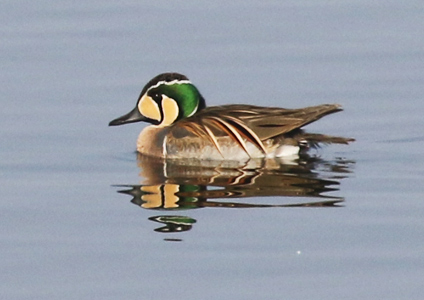
Baikal Teal 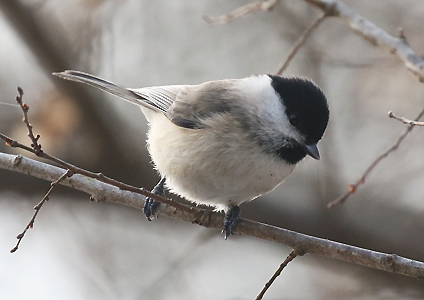
Marsh Tit 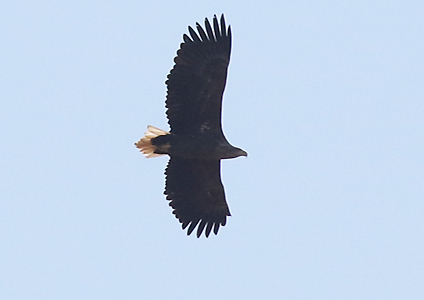
White-tailed Eagle 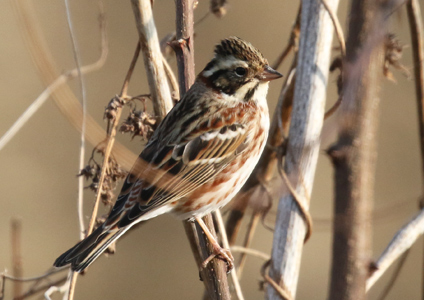
Rustic Bunting
